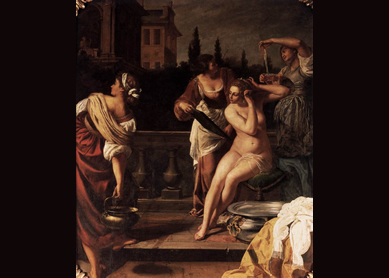“David arose from off his bed, and walked upon the roof of the king’s house: and from the roof he saw a woman washing herself; and the woman was very beautiful to look upon. (
The question is, when David saw the woman bathing, was he looking at a naked woman?
Why ask the question? Well, for an artist, it may be the practical matter of how to depict the woman. There are, in fact, many naked Bathshebas, including the famous one now in the Louvre painted by Rembrandt in 1654. But, as the history of biblical interpretation shows, it may also be a matter of morality: the answer to the question may be used to shift blame for the king’s adultery from David to Bathsheba.
Many an interpreter has held Bathsheba to be at fault for showing herself naked to the king—for seducing him. This judgment is nicely encapsulated in the comment accompanying a picture of a naked Bathsheba bathing from a late 15th-century book of hours (a devotional book for laypersons) reproduced on the website of the Victoria and Albert Museum in London:
[The French artist] Bourdichon portrayed her as a self-conscious temptress displaying her charms, which accord with the highest standards of feminine beauty current in the fifteenth century.
Bourdichon followed the custom of late medieval illuminated books of hours and psalters in showing Bathsheba standing naked in a pool with a fountain. However, the earliest printed Bibles with embedded woodcut illustrations, produced in the late 15th century first in Cologne and then in Nuremberg, show a very different Bathsheba. She is clothed. Holding up the hem of her dress, she sits with her feet in a bowl. In Luther’s 16th-century German Bibles, she usually sits beside the castle moat with a servant washing her feet.
Does this difference mean that the Cologne/Nuremberg and Luther Bibles were shifting blame away from Bathsheba and back to David? Maybe so, although there are other possibilities. We could ask another question: What does bathing mean? Indeed, what does nakedness mean?
The bathing Bathsheba of the books of hours is accompanied by the words of the penitential psalm, “Domine ne in furore tuo arguas me” (“O Lord, do not rebuke me in your anger” [
Bourdichon’s Bathsheba bathes alone. But for upper-class women in the late Middle Ages and early Renaissance, bathing was often a social occasion. And men could be present, especially as servants or musicians. In other words, naked bathing was not the problem. Men’s lust was the problem.
Why is Bathsheba clothed in the German Bibles? Perhaps because northerners were prudish. Or perhaps it is because washing hands and feet was what “bathing” normally meant for most northern Europeans at the time (and for centuries later). Their water source, a stream or spring-fed fountain, was often in a public place. So what else would Bathsheba be doing but having a foot bath?
Today, a few centuries after the invention of privacy and indoor plumbing, it is easy for Westerners to assume that Bathsheba was bathing naked—and, because she was visible, some might argue that she was doing so inappropriately. But what “bathing” means in the world of the biblical story remains unknown. Some think she was taking a ritual bath (Hebrew, mikveh) after her menstrual period (citing
What does the Bible say? He saw a woman bathing, and she was beautiful.
Bibliography
- Backhouse, Janet. Books of Hours. London: The British Library, 1985.
- Vigarello, Georges. Concepts of Cleanliness: Changing Attitudes in France since the Middle Ages. Translated by Jean Birrell. Cambridge and New York: Cambridge University Press, 1988.
- Duby, Georges (ed.). A History of Private Life. II. Revelations of the Medieval World. Translated by Arthur Goldhammer. Cambridge, Mass.: Belknap, 1988.




